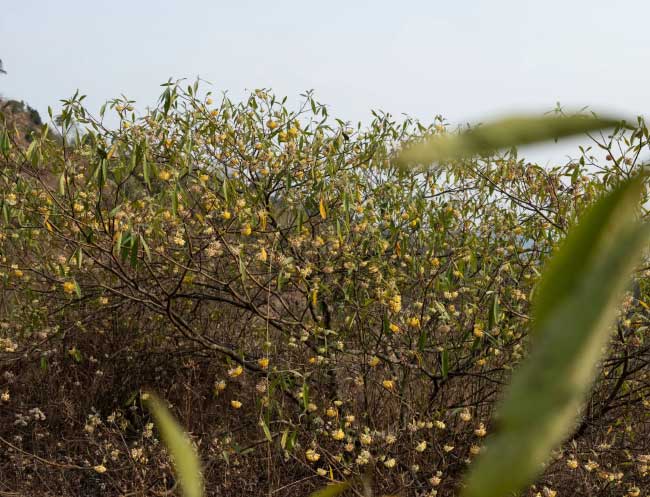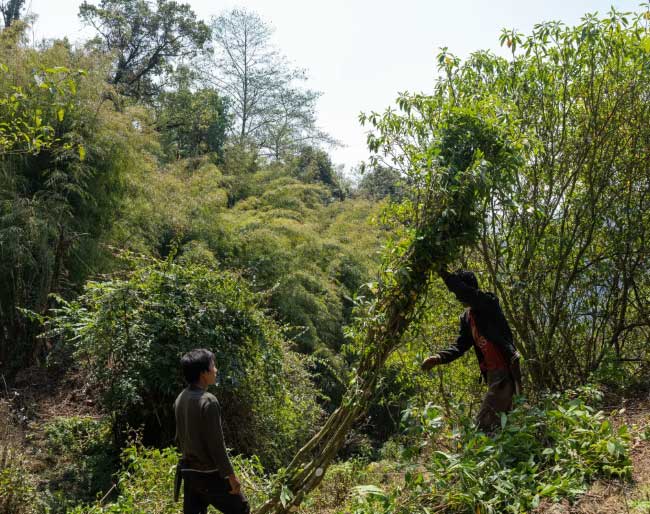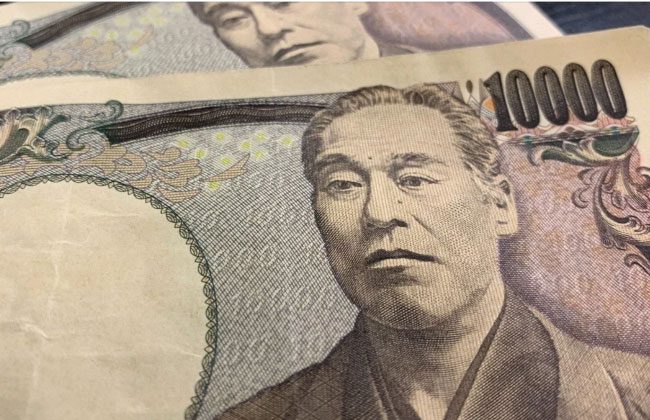A type of shrub growing on the impoverished hillsides of Nepal is providing raw materials for making banknotes used in Asia’s most complex financial system.
The scenery is truly breathtaking in this eastern corner of Nepal, nestled between the world’s highest mountains and the tea plantations in Darjeeling, India, where rare orchids bloom and red pandas frolic on the lush slopes.

Wild argeli growing in the Himalayas. Before Japan began purchasing it for currency production, the primary use of argeli in Nepal was as firewood or for fencing. (Photo: NYT).
However, life for the local people can still be challenging. Wildlife destroys the corn and potatoes of Pasang Sherpa, a farmer born and raised near the summit of Everest. About a decade ago, he abandoned those crops and switched to growing a plant that seemed to have little value: argeli – a flowering shrub with yellow blooms that grows wild in the Himalayas. Farmers often cultivate it for fencing or firewood.
Initially, Pasang had no idea that the bark stripped from his argeli trees would one day turn into money. This is the result of an unusual trade: one of Asia’s poorest regions supplying key raw materials for currency in the wealthiest economy.
The Japanese yen is printed on a special type of paper that is no longer produced domestically. The Japanese have a fondness for old-style yen notes, and this year they need mountains of new currency, giving Pasang and his neighbors a lucrative reason to stay on their hillsides.
Pasang said: “I never thought these raw materials would be exported to Japan or that I would make money from this plant. But now I am very happy.”

Workers hired by Pasang to cultivate and harvest argeli. (Photo: NYT).
4,500 kilometers away from Pasang’s home, in Osaka, Kanpou Incorporated produces the type of paper used by the Japanese government for official purposes. One of Kanpou’s charitable activities has been surveying the foothills of the Himalayas since the 1990s to help local farmers dig wells. By chance, they discovered a solution to Japan’s problem.
The supply of mitsumata, the traditional paper used for printing yen, is dwindling. The pulp used to make it is sourced from plants of the Thymelaeaceae family, which grow in high altitudes with moderate sunlight and drainage. However, rural depopulation and climate change are causing Japanese farmers to abandon the lands where these plants are cultivated.

Yen currency made from pulp sourced from Thymelaeaceae plants. (Photo: Mainichi).
The president of Kanpou at that time knew that mitsumata originated from the Himalayas. After years of experimentation, the company discovered that argeli, a sturdier plant of the same family, grows abundantly in Nepal. Farmers here just needed guidance on how to care for it to meet Japan’s strict standards.
A quiet revolution occurred after the devastating earthquake that struck much of Nepal in 2015. The Japanese sent experts to the capital, Kathmandu, to help Nepalese farmers participate in the process of creating the crisp, durable yen notes.
Initially, Pasang ventured into business and produced 1.2 tons of bark each year, manually stripping the bark and boiling it in wooden barrels.
But then, the Japanese taught him how to steam the bark using plastic bundles and metal pipes. The process of stripping, beating, stretching, and drying became labor-intensive. The Japanese also instructed their Nepalese suppliers to harvest just three years after planting, before the bark turned red.

Workers stripping argeli bark in Nepal. (Photo: NYT).

Workers drying argeli bark in Ilam District, Eastern Nepal. Thousands of miles away, in Japan, this bark will be used to make yen banknotes. (Photo: NYT).
This year, Pasang has hired 60 local Nepalese to assist with the harvest and expects to earn 8 million Nepalese rupees, equivalent to $60,000, in profit. (According to the World Bank, the average annual income in Nepal is about $1,340.) He hopes to produce 20 of the 140 tons of paper material that Nepal will transport to Japan.
This is the amount of mitsumata needed to print enough yen to fill about 7 shipping containers, flowing down to the port of Kolkata in India, and then taking a 40-day journey to Osaka.
Mr. Shreshta, who is fluent in Japanese, stated: “As a Nepalese, I feel proud to manage the raw materials for printing money in wealthy countries like Japan. It is a wonderful moment for me.”
This is also a significant time for the Japanese yen. Every 20 years, the world’s third most traded currency is redesigned. The current notes were first printed in 2004, and the new replacement notes will reach cashiers in July.

New banknotes that Japan will issue this year, made from paper sourced from argeli bark. (Photo: Kyodo News/Getty Images).
The Japanese love beautiful banknotes with elegant designs, refined with moiré printed on durable plant fibers, in a light white color rather than cotton or polymer.
The yen is also an exception in Asia. Less than 40% of payments in Japan are processed by card, code, or phone, while in South Korea, that number is around 94%. Even for Japan, where cash is becoming increasingly less prevalent; the value of circulating banknotes reached a peak in 2022.
The Bank of Japan reassures everyone that, if they exchange an old yen note for a new one, they still ensure enough physical currency is in circulation. If stacked in one place, the banknotes would reach a height of 1,840 kilometers, which is 491 times taller than Mount Fuji.


















































